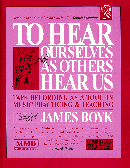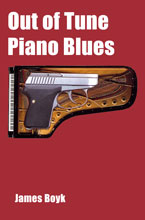Books, Articles, Papers & Seminars by James Boyk
Books
Out Of Tune Piano Blues
|
|
Mystery Novel Just Out
A puzzle that only a musician could solve; a
mystery that only a musician could write. Concert pianist Arthur
Singer, age 30 in his 18th year on tour, is in danger of burnout.
Performing and teaching at Wisconsin University at Black Falls is what
he needs, says his manager. But passion and homicide supervene, in
this "absolutely original" mystery "teeming with life and its perils
and joys," with "characters alive and real, their voices distinct."
"A stunning debut novel exploring loneliness, love and professional identity."
|
To Hear Ourselves As Others Hear Us
 This little volume is several books in one: First, it is a complete guide to using recording as a tool in practicing, teaching and preparing for performance, for musicians of all instruments and ages. Second, it is also a guide to microphones and other recording gear, by a recognized expert. Finally, the many amusing anecdotes and poetic reflections make it a reading delight.
This little volume is several books in one: First, it is a complete guide to using recording as a tool in practicing, teaching and preparing for performance, for musicians of all instruments and ages. Second, it is also a guide to microphones and other recording gear, by a recognized expert. Finally, the many amusing anecdotes and poetic reflections make it a reading delight.
"A treasure-trove of information, advice and entertaining musical insights for both amateur and professional musicians. James Boyk's enthusiastic philosophy for musical excellence is contagious, and should be required reading for all lovers of music." –André Watts
"All how-to books should be like this one: useful, cheerful, inspirational, thought-provoking, and so complete and clear as to be more than user-friendly�indeed, user-solicitous.... Boyk has the temperament to be both mechanical and artistic, and the wisdom to see both paths in the service of the same goal." –Dr. Bradford Gowen, Piano & Keyboard.
"Bravo for this little gem of a book. It is one that all piano teachers, students and parents should take the time to read, and then read again. The insights and advice are too many to skim through and too good to digest at only one exposure." –Dr. John Zeigler,
Piano Education Page.
"If I were giving instrument lessons, I'd buy this thing by the case. It could be the best ten bucks you or your whiz-kid will spend in a long time." –Steve Taylor, Whole Earth Review, Winter, 1997.
"I highly recommend To Hear Ourselves As Others Hear Us.... The book offers so many...pedagogically sound and cleverly presented ideas that I can only encourage you to buy it and discover for yourself its many insights into performing, practicing, teaching, and listening." –Dr. Ray Landers, American Suzuki Journal, Winter, 1999.
"Know Thy Piano"; published in this Web site. Ultra-short essays about things pianists need to know.
"A Musician's ABCs"; published in this web site.
~
Articles, Papers & Seminars
"Keys to Success," New West, October 24, 1977. Includes How To Buy a Piano and What I Learned From Writing This Article.
Called "the best statement of the philosophy of music education we've ever seen" by the Music Education Division of Yamaha International, which distributed 11,000 reprints. Nominally about how to choose a music teacher; actually much broader.
"The Perfectly Complete, Completely Perfect, Thinking Person's Guide to Stereos," New West, Sept. 11, 1978.
Finalist in the National Magazine Awards. Feature article on choosing stereo equipment by critical listening. How to "add up virtues" to draw valid conclusions about sound quality in uncontrolled environments. Pitfalls of the retail audio scene.
"The Music Goes Round and Round and It Comes Out Here," New West, Jan. 1, 1979.
Short introduction to technology of recording and playback.
"Tuning the ill-tempered clavier" (letter) Am. J. Phys.,
47(5), May 1979, pages 475-475.]
A concert grand piano is not merely a bigger version of a baby grand. Rather, it is the one and only piano whose size is determined by acoustic, mechanical and materials engineering reality alone. It is the ideal size piano. I feel that the word piano should be reserved for the concert grand, and another word should be invented for small grands & uprights. Pianette would do.
"Oldies But Goodies," New West, Aug. 13, 1979.
Hi-fi equipment that has passed the tests of time and the market.
"The Cartridge Family," New West, Oct. 22, 1979.
Review of five phonograph cartridges.
"The Ear of the Beholder," New West, July 14, 1980.
The idea of beauty as a concrete aid in judging audio equipment.
Program Notes for album "Boyk plays Schumann & Chopin," of Schumann's 'Scenes from Childhood,' Opus 15, and Chopin's Fantasy in F Minor, Opus 49, Performance Recordings® pr2, 1980.
"The Music Lover's Quick But Accurate Guide to Stereo," The Next Whole Earth Catalog, 2nd edition, 1981.
"The Music of Sound," guest editorial in The Audio Amateur,
issue 5, 1982. Reprinted in Hi-Fi News & Record Review (England), Sept. 1985.
The sound itself is part of the meaning of the music.
Program Notes for album "Boyk Plays Prokofiev," of the Sixth Piano Sonata, Opus 82, Performance Recordings® pr3, 1982.
"Rules of the Game," Hi-Fi News & Record Review (England), Jan., 1983.
On evaluating audio equipment: "The danger in evaluating a new technology is that the old technology has shaped our perception. If Old defects are corrected in the New, we will notice that fact vividly. What we may miss is the presence of New defects for which we have no established perceptual categories."
C. Minor, M. Todorovich, J. Boyk, G. P. Moore, "A Computer-Based Keyboard Monitor for Studying Timing Performance in Pianists" in Timing and Time Perception, J. Gibbon and L. Allen, eds. Annals of New York Academy of Science 1984; 423, 651.
Work done by Prof. George Moore of USC with Minor and Todorovich, students in JB's course "Projects in Music & Science."
"Controversy I: The Digital Wars," in The Absolute Sound, Summer, 1984.
A letter with inside information.
"Comment," guest editorial, Hi-Fi News & Record Review (England), Dec., 1984.
Of restaurants, view cameras, coffee and listening-tests of audio equipment.
Program Notes for Boyk album of Debussy's Reflections in the Water, Stravinsky's Sonata (1924), Schoenberg's Six Little Piano Pieces, Opus 19, and Ravel's Sonatina; Performance Recordings® pr4, 1984.
"Dynamic Inflection and the Beauty of Live Music," Hi-Fi News & Record Review (England), June, 1985.
Introducing a new term for equipment evaluations.
"On Both Sides of the Microphone," The Audio Amateur, issue 1, 1986.
How musical considerations affect technical decisions in recording.
"About single, double & treble-blind testing," Letter in Hi-Fi News & Record Review, March, 1986.
"Bi-Wiring," Stereophile, November, 1987.
Results of a project in James Boyk's Caltech course "Projects in Music & Science" carried out by Caltech undergrad Bruce Tiemann. A Spendor BC3 (4-way) loudspeaker was bi-, tri- and quad-wired and the these were compared in sound quality to normal wiring and to normal wiring with the same amount of copper as the total in the separate wirings. "Our conclusions: Yes, multi-wiring changes the sound, and to a surprising degree. No, it's not just due to more copper between power amp and speaker.... And No, multi-wiring is not necessarily [sonically] better."
"Backstage Info...on Microphones and Stereo," in booklet
of Performance Recordings album pr6cd, Demonstration of
Stereo Microphone Technique.
A primer of microphones and stereo.
"Audiences of the World, Arise!," Harvard Magazine, Nov.-Dec., 1990. Reprinted as "When The Absolute Sound Isn't" in The Absolute Sound, issue 73, 9/10/91.
Why we get bad concert halls. "America's concert halls do not fail on subtleties; they fail on obvious things."
Program Notes for Boyk album of Mussorgsky's Pictures at an Exhibition, Performance Recordings® pr7lp & pr7cd, 1990.
1990 vs. 1960 in Audio, The Absolute Sound, ca. 1990.
A light letter pointing out some amusing constants in the audiophile scene.
Program Notes for album "Boyk plays 20th-Century Masters," Performance Recordings® pr8cd, 1991.
Program Notes for album "Boyk plays Beethoven," Performance Recordings® pr9cd, 1991.
"10 feet, 1¼ Inches," Los Angeles Times Magazine, Oct. 1, 1995.
Playing the world's longest piano, the Fazioli F-308.
"The Endangered Piano Technician," Scientific American, December, 1995. Reprinted in Piano & Keyboard, May-June, 1996.
The cultural crisis caused by the scarcity of fine concert piano technicians.
"Aube Tzerko As I Knew Him."
Memoir of a famous piano teacher.
"In Love With Sound," published in this Web site.
Personal essay.
"There's Life Above 20 Kilohertz: A Survey of Musical-Instrument Spectra to 102.4 kHz"
"At least one member of each instrument family (strings, woodwinds, brass and percussion) produces energy to 40 kHz or above, and the spectra of some instruments reach the measurement limit of 102.4 kHz. Survey includes French horn, trumpet, violin, oboe, crash cymbals, sibilant speech, claves, a drum rimshot, triangle, jangling keys, and piano. Includes short description of others' work on perception of air- and bone-conducted ultrasound, and points out that even if ultrasound be taken as having no effect on perception of live sound, yet its presence may still pose a problem to the audio equipment designer and recording engineer.
"Improving Your Writing Through Editing"; published in the Caltech Music Lab Web site.
Description of a helpful technique Boyk invented.
Gerald J. Sussman, James Boyk, "Small-signal distortion in feedback amplifiers for audio." April 22, 2003. In Acrobat and Postscript formats.
"Capturing Music: The Impossible Task." EE Special Seminar at invitation of Electrical Engineering Dept., University of California at San Diego, April 8, 2004.
Abstract: The real piece of music is the sound the composer heard in imagination. For the performer trying to recreate this in the listener's ears, details of the sound have profound implications. The performer operates in a feedback loop with the instrument and the room acoustics (and the audience, if one is present). A recording which alters the sound outside this loop may falsify musical meaning. Most recordings don't serve the music well because of such errors and/or because audio gear isn't good enough. The latter comes about partly for lack of scientific knowledge of the ear-brain system, and partly because standard technical "specs" don't correlate with sound quality. One new spec holds out hope for better correlation, and should be followed up. Certain aspects of audio performance may always be difficult to measure, however. Until we have specs known to correlate with and to tell all that's needed about audio performance, designs must be evaluated by listening. The musician's trained ears can help with this, while the engineer contributes not only the design but the technical and procedural knowledge to define conditions for meaningful listening. Listening is most revealing when carried out by comparison with an impeccable original: either live sound or a direct microphone feed of high quality. Blind tests are a "gold standard," but are sometimes inherently impossible. Respect for the non-blind listening skills of professional musicians and recording engineers is reassuring.
Letter published in The New Yorker, Oct. 8, 2007 (Complete text here)
Editor: Mark Singer, in his exploration of how William Barrington-Coupe passed off as the recordings of his wife, the pianist Joyce Hatto, performances by other musicians, writes that Barrington-Coupe claimed that he spliced into her recordings patches of performances by other pianists with similar styles ("Fantasia for Piano," September 17th). "My wife was completely unaware that I did this," Barrington-Coupe says. "I simply let her hear . . . the finished editing that she thought was completely her own work." This is unbelievable, and outright impossible if the pianists play at such different levels as reported of Hatto and her substitutes. If Joyce Hatto had been an actress into whose audio-recording of Ophelia her husband had spliced patches of other actresses with "similar styles," no one would believe she could remain unaware of it. Difference in actresses' voices would be a strong clue in that case; but pianists, too, have their own "voices."
Letter published in HiFi Critic, Oct. 12, 2007 (submitted Sept. 20, 2007)
Digital converter format versus performance. "People are discussing '24-bit sound' when they haven't even heard 18 bits."
Copyright © 1997-2010 James Boyk. All rights reserved to this and all other pages in this site.
Performance Recordings®
Home | Books & Articles | Albums | "Musician's Ear" microphone | Contact us


 This little volume is several books in one: First, it is a complete guide to using recording as a tool in practicing, teaching and preparing for performance, for musicians of all instruments and ages. Second, it is also a guide to microphones and other recording gear, by a recognized expert. Finally, the many amusing anecdotes and poetic reflections make it a reading delight.
This little volume is several books in one: First, it is a complete guide to using recording as a tool in practicing, teaching and preparing for performance, for musicians of all instruments and ages. Second, it is also a guide to microphones and other recording gear, by a recognized expert. Finally, the many amusing anecdotes and poetic reflections make it a reading delight.